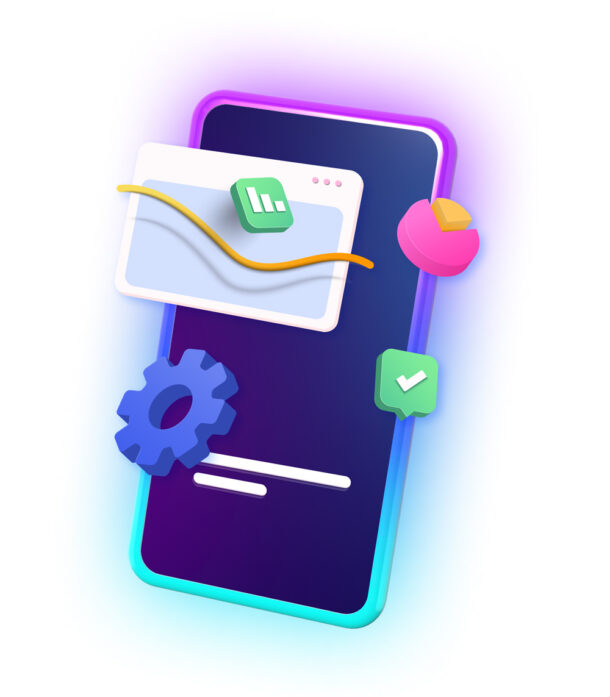Want to learn the basics of mobile user acquisition?
You’re in the right place!
In this article, we’ll go over everything you need to know to get started with mobile user acquisition.
Already an expert in UA? In that case, skip the basics and dive right into our mobile advertising articles that match your level.
What is Mobile User Acquisition?
To define, mobile user acquisition (also known as UA) is the process of driving new users to mobile apps and games through different marketing strategies.
UA is an integral part of growing mobile apps. Without it, an app’s chances of success are about as slim as winning the lottery.
The purpose of mobile user acquisition is to increase app visibility, drive traffic, and deliver app users who will generate revenue.
The ultimate goal is to achieve all this at the lowest possible cost and with a positive return on investment (ROI). In other words, acquired users should bring in revenue that is higher than the cost of acquiring them.
In a nutshell, the process of mobile user acquisition includes:
- reaching a relevant target audience
- encouraging users to install and use the app
- turning them into active users who generate revenue
Types of Mobile User Acquisition

You can acquire app users in more than one way. The most common mobile user acquisition strategies include:
Paid user acquisition. Investing in ad campaigns on different channels and ad networks to serve ads to a relevant audience and drive app downloads. For example, in-app advertising, social media advertising, and influencer advertising.
Organic user acquisition. Using unpaid channels and strategies to attract users to the app. This includes app store optimization (ASO), word-of-mouth, active social media presence, etc.
Owned user acquisition. Acquiring users through channels the business already owns and controls. For example, website traffic, email marketing, and cross-promotion within the app portfolio.
Getting Started With Mobile User Acquisition
If you’re new to mobile user acquisition, you’re probably unsure where to start.
Here are the first steps app marketers typically take in their UA journeys.
1. Defining the App’s Purpose and Target Audience
Before jumping into UA, make sure you have a great understanding of the purpose of your app and its target audience.
You can get started with this by asking yourself the following questions:
- What problems or needs does my app address?
- Which group of people is most likely to use it?
- What demographics, interests, and behaviors do these users have?
- How will they use it?
Answering these questions can help you lay a solid foundation for effective user acquisition. With these insights in mind, you should be able to develop basic messaging and targeting strategies.
2. Analyzing the Competition
Another starting point in mobile user acquisition is looking into your competition. Your goal here is to find out how similar apps approach UA, and detect their strengths and weaknesses.
To find this out, analyze:
- Which channels they use to acquire users
- Their messaging strategies
- Where most of their downloads come from
- Their user reviews and ratings
To conduct this kind of analysis, you don’t need to spend money on fancy tools.
For example, if you want to see their ad creatives, you can usually find them in ad libraries provided by different ad networks (e.g. Facebook Ad Library). Or if you want to know which countries these apps are most popular in, you can use the free features of mobile intelligence tools.
3. Choosing UA Channels
At this point, you have a solid idea of who your target audience is and how your competition approaches UA.
Based on this, you can select appropriate UA channels.
The main question here is — where does your target audience spend their time?
The key to reaching your target audience is to understand their online habits and preferences.
For example, if your target audience is Gen Z in the US, it makes sense to try and reach them on their most used social media channels, TikTok and Snapchat. If you want to reach fitness enthusiasts of all ages, consider placing ads in other fitness apps, and platforms such as Instagram and YouTube where fitness-related content is popular.
4. Determining KPIs to Track
Mobile user acquisition is extremely data-driven.
To be able to measure success, and develop and optimize UA strategies, you’ll need to determine KPIs (key performance indicators). These are different mobile advertising metrics that tell you how successful your UA strategies are.
Here are some UA metrics mobile marketers often track:
- CPA (Cost per action)
- CPI (Cost per install)
- Conversion rate
- Retention rate
- LTV (lifetime value)
- ROAS (return on ad spend)
- ROI (return on investment)
While you can track all these metrics, you should only select a few as your KPIs.
The KPIs you select depend on what you want to achieve with your UA campaigns.
If you want immediate installs, focus on metrics like CPI and conversion rates. If your goal is long-term engagement, it makes more sense to prioritize metrics like retention rate and LTV.
5. Testing and Optimizing
User acquisition is not a one-time job.
Once you get started with it, you need to continue taking care of it. It’s like planting a seed, watering it, and watching it grow.
To “grow” successful UA campaigns, you’ll need to continuously test and optimize them. This includes experimenting with different ad creatives, text, targeting options, etc. A commonly used strategy for this is A/B testing, which allows you to compare two different ad elements and determine which performs better.
Popular Mobile User Acquisition Strategies
With so many mobile user acquisition strategies at your disposal, choosing the ones to focus on can be tricky.
To help you out with this, we’re bringing you an overview of tried-and-true UA strategies for 2024 and beyond!
Video ads

Video advertising is a staple of app advertising.
Video ads allow you to showcase the main features and benefits of your app to grab the users’ attention and encourage app downloads. You can use video ads for paid user acquisition on different platforms, from social media to in-app advertising.
When it comes to the content of these videos, you can play as much as you want.
For example, some users respond well to simple video ads (e.g. gameplay, app features), while others prefer more attention-grabbing content (e.g. influencer videos, social media trends). Lately, we’re seeing a lot of AI-generated video content as well.
Video ads can appear in different formats. For example, as in-stream and in-feed ads on social media, or as interstitial ads and rewarded video ads within other apps.
ASO
ASO (app store optimization) is a set of techniques app publishers use to optimize their app store listing. This includes optimizing the app title, description, icon, screenshots, keywords, etc.
ASO is the SEO for the app world.
Just like websites compete to reach the first page of Google, apps compete to appear at the top of app store searches. Therefore, If you want to reach users while they browse the app stores, invest time in ASO.
Thanks to ASO, apps become more visible, rank higher in search results, and stand out among the competition.
Offerwalls

Offerwall advertising is a form of paid advertising within mobile apps and websites.
Offerwall ads appear as “walls” listing different “offers” in apps or websites. By completing actions listed on offerwalls, users earn rewards.
For example, users can be asked to download another app, complete a survey, or reach a certain level in a game. In exchange for doing so, they can win in-app currency or other rewards.
Oferwalls have recently gained extra popularity over traditional methods of paid user acquisition.
The reason for this is their ability to deliver high-quality app users with high retention rates and ROAS. Check out how the renowned finance app Revolut and Midnite Games grew their userbases with offerwall ads.
Mixed UA Strategy
Most app marketers don’t rely on just one UA strategy.
You don’t want to put all your eggs in one basket.
Instead, smart marketers combine different UA strategies to attract users from different channels. It’s nothing unusual to leverage video ads, ASO, and offerwall ads at the same time.
By leveraging multiple channels, marketers create a balanced and resilient mobile user acquisition strategy that doesn’t depend on a single channel. A mixed UA strategy also helps reach a diverse potential audience and capitalize on the unique strengths of each method.
Challenges of Mobile User Acquisition
Before embarking on your mobile user acquisition adventure, note this.
As time goes by, user acquisition is getting more and more challenging.
Here are some of the biggest UA challenges app marketers face in today’s app market.
Rising User Acquisition Costs
The mobile app market is overcrowded and saturated.
Because of this, standing out from the competition has become more difficult — and expensive.
This is especially true for traditional UA methods like video advertising on platforms such as Facebook and Google. Since the majority of advertisers use these ad networks, this increases advertising costs for everyone involved.
For this reason, more and more advertisers are turning to less saturated UA channels and exploring new ways to reach out to users.
Privacy Regulations
Privacy regulations have brought seismic changes to the way user acquisition works.
Previously, app advertisers had unlimited access to user-level data, allowing them to create highly targeted, personalized ad campaigns.
Things started changing when Apple introduced its ATT (App Tracking Transparency) privacy framework in 2021. On top of that, Google is following suit with its Privacy Sandbox which is coming into force by the end of 2024.
These regulations prioritize user privacy and limit the amount of user data available, so advertisers need to adapt their strategies. For example, due to these changes, many marketers changed their focus from collecting third-party data to first-party data.
Shift from User Quantity to User Quality
In the early days of mobile app advertising, it was possible to acquire a large number of users at a low cost and achieve a positive ROI.
Back then, UA marketers around the world were hyper-focused on one goal — achieving a low CPI (cost per install).
Today, this is no longer the case.
In the last few years, app marketers have become more focused on user quality over user quantity.
Due to rising advertising costs, they are focusing on acquiring users who will continue using the app, show long-term loyalty, and generate revenue. Because of this, they now pay more attention to metrics like retention rate, LTV, and ROAS rather than CPI.
Mobile User Acquisition Wrap-up
Congratulations, you are now familiar with the basics of mobile user acquisition.
At MAF, we’re experts in user acquisition for mobile apps and games. Through our own ad network, we help apps reach high-quality audiences at scale. If you’re interested in hearing more, reach out to us directly!







